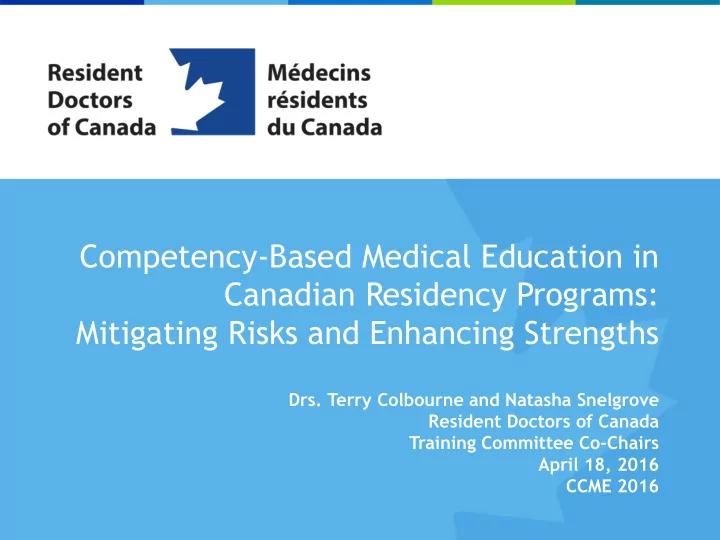

Competency-Based Medical Education in Canadian Residency Programs: Mitigating Risks and Enhancing Strengths Drs. Terry Colbourne and Natasha Snelgrove Resident Doctors of Canada Training Committee Co-Chairs April 18, 2016 CCME 2016
CBME in Canada Competency-Based Medical Education (CBME) is becoming a reality nationally and internationally o Transition from strictly time-based training o Need to demonstrate competence through ‘milestone’ achievement CanMeds 2015 and The Royal College of Physicians and Surgeons of Canada’s Competence -by-Design (CBD) project o Medical Oncology and Otolaryngology in 2017 o Gradual implementation over next decade The College of Family Physicians of Canada’s Triple C Curriculum o Comprehensive, Continuity, Centred in Family Medicine
Methodology PubMed search o Query: Medical residency OR graduate medical education AND competency-based medical education AND 2010-2015 o Results: 720 articles cross-referenced for relevance o Abstracts screened for relevance leading to 64 short-listed works Key paper on CBME (Frank et al. 2010) was cross-referenced identifying 21 additional articles Additional 18 papers of relevance identified through CFPC In total, 103 articles served for literature review
Four Key Themes Transition to CBME Curriculum Design Assessment and Promotion Resources
Transition to CBME A number of lessons are described that promote successful implementation of CBME (Carraccio, 2013): o A need for standardized language o Direct observation in assessment o Development of meaningful measures of performance o Desired outcomes as the starting point for curriculum development o Dependence on reflection in the development of expertise o Competent clinical systems as the required learning environment for producing competent physicians
Transition to CBME – Barriers The most commonly identified barriers (adapted from Malik, 2012): o Lack of time o Lack of faculty support o Resistance of residents, low organizational priority o Lack of funding/Inadequate salary support for administrators o Inadequate knowledge of competencies
Transition to CBME – For Action A clear, robust and comprehensive transition strategy/framework for faculty development A standardized language for CBME Faculty development, resident empowerment and early education as a key part of the transition o Establish CBME champions and coaches who can mentor and guide Collaboration, coordination and information exchange between local and national planning efforts and among programs
Curriculum Design Key Questions: o Will the curriculum be beneficial for trainees? o Will trainees be available to participate in curricula and provide care without lengthening service hours? o How are residents in traditional training programs affected? o Who should establish and validate curricula?
Curriculum Design Training that reflects future practice o Through Milestones and Entrustable Professional Activities (EPAs) that are well designed and valid to ensure competency Real-time feedback Clear expectations Self-directed learning o Through simulation opportunities, facilitated cases, research activities Accountability, flexibility, and learner-centredness o Individual focus, training design to reflect dynamic learner needs Hierarchical skills development
Curriculum Design – For Action Training requirements and service expectations must be clearly defined High thresholds for achievement continue to be developed in a manner that does not over-burden faculty and residents Discrete milestones and EPAs should reflect future practice, avoid reductionism Programs must ensure a sufficient variety and depth of clinical exposure to meet necessary milestones and attain EPAs Novel approaches to service scheduling and delivery should be considered to ensure equity among residents regardless of whether they are in traditional or CBME training cohorts As evidence of CBME curricular approaches is limited, continuous quality improvement must occur
Assessment and Promotion Increased reliance on Direct Observation and Global feedback o Assessment fatigue Not all competencies are created equal o No single tool will sufficiently evaluate all competencies o Common tools fail longitudinally Who is ultimately responsible for promotion? PD? Committee? College certification? o Exam timing and content o Reflective of stage of training?
Assessment and Promotion – Best Practices Method(s) adapts to environment and to skills being evaluated Multiple evaluators and assessment tools o 360 degree evaluation, formative feedback, guided self-assessment, regular face-to-face meetings, OSCEs Portfolios o Promotes self-reflection, cumulates evidence, teaches PBL skills o BUT - What goes in it? Who owns it? Who has access? Formative experiences and self-evaluation o Field notes
Assessment and Promotion – For Action Multiple assessment tools, enlist various assessors, adapt between learning environments A learning portfolio should track resident progress through a training program o Access/ownership of information defined and security ensured Residents requiring additional resources identified early Promotion and declaration of competency, independent of exams, should be the program’s responsibility, preferably by committee Licensing and certifying examination content should accurately reflect stage of training and competency, regardless of timing
Resources Do programs and faculty in today’s system possess the capacity to participate in a CBME model? Shift from their educational roots Increased time commitments required o More robust and frequent assessments, direct observation Limited resources for compensation o Provision of service and education o Unique and unexpected challenges o Considerable focus on providing faculty training needed
Resources – For Action Time demands for resident and faculty must be respected Adequate physical, human, financial and technological resources to support transition o Ongoing commitment of resources by programs and departments o Sufficient support for staff for required direct assessment o Find strategies to be cost- effective, including finding “lean” observation strategies
Thank you! Any questions? References available on request tcolbourne@residentdoctors.ca nsnelgrove@residentdoctors.ca
Recommend
More recommend